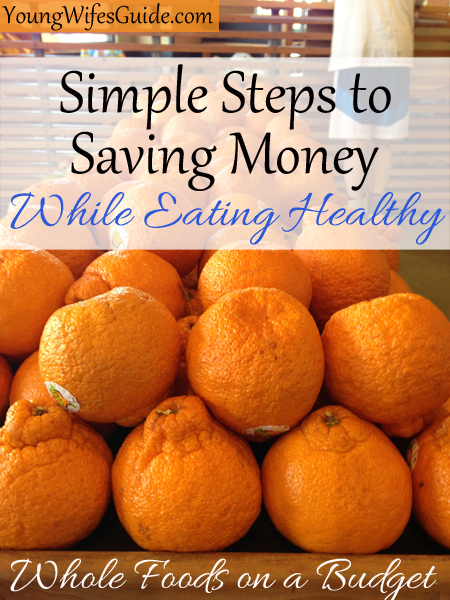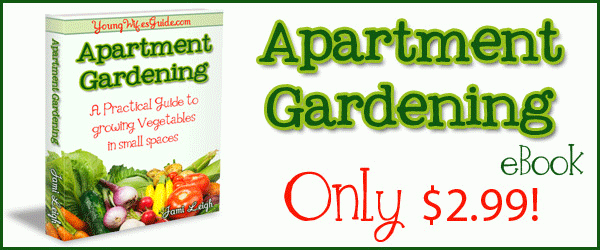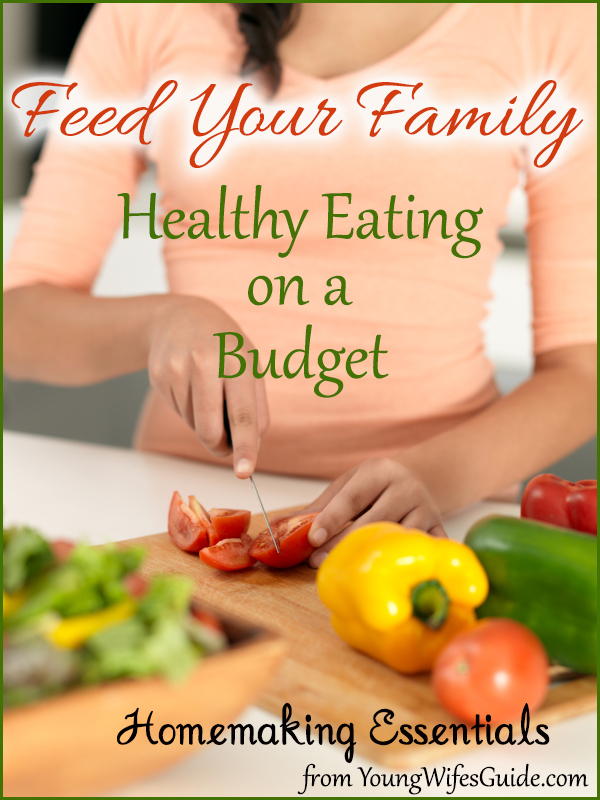Real Food on a Budget {Part 1}: Simple Steps to Saving Money
I am finally getting into gear and making sure that our family eats a healthy, real foods diet this year! I began looking into a healthier diet a few years ago and have slowly implemented real food and natural living things into our lifestyle. I was overwhelmed at first and didn’t know where to start.
I didn’t want to rush out to a natural foods store, spend a million dollars, and then not actually use the things I got! So slowly, one item at a time, I am converting our diet and our lifestyle to a healthier one.
One huge lesson I have learned through my whole foods journey is…eating healthy doesn’t have to be expensive! We are on a tight budget, and I initially thought that there was no way we could start eating organic produce or grass fed beef. But with a little planning ahead, a lot of research {which I’m going to share with you}, and some good elbow grease, eating healthy on a budget CAN be done, and it’s easier than I thought!
Steps to a Healthy Real Food Budget
1) Shop Seasonally
About.com has a great list of each state’s fruit and vegetables seasons. Find your state and then you can get a general idea of what grows seasonally in your area.
Tomorrow I will share some specific places to shop to save money and knowing what’s in season will really help. When you shop for fresh local produce that’s in season, you are getting the best bang for your buck!
2) Meal Plan
This is one of the biggest ways you can save money while eating a healthy diet. Plan out your meals! Find out what is in season in your area and plan your meals around that.
Stephanie from Keeper of the Home wrote a fantastic book on the subject, Plan it don’t panic! For only $4.99 you can instantly download this great resource. Not only does she include fantastic tips and will help you develop a fast meal plan and grocery shopping plan, she also provides you with 4 real food menu plans!! I highly recommend this eBook if you want to learn how to really menu plan.
3) Shop Different Stores
To get the most of your grocery budget, be prepared to shop at a few different stores. Before I had my twin boys, I could easily visit 4-5 stores a week, no problem! Of course, now this is impossible. I am lucky if I can get to two stores! So I get creative, plan my shops out very well, and do a lot of shopping online.
The point of shopping at a few different stores is that you can shop the sales. You can find out which store has the best produce on sale, who has the best meat, and maybe a third store has a killer sale on eggs and milk. By taking a little time and going to three stores you can really save a ton of money by planning strategically. Tomorrow I will share some specific stores that I love.
4) Get Creative!
Since starting a real, whole foods diet, we have tried a lot of different meals. I have stepped outside my kitchen comfort zone and found new meals that we love. We have also started stretching meat out in meals and even having days of NO meat in our dinner {this is a huge adjustment for my husband since he feels like it’s just not a meal without meat}!
This Traditional Menu Plan really helped me in this. Diana designed her meal plans and recipes to use fresh seasonal produce as well as meats and ingredients that are inexpensive but still super healthy. I highly recommend her menu plans!
5) Make a Price Chart
I started doing this a few years ago when I first got married because I wasn’t very good at knowing when things were rock bottom prices. Sometimes a “sale” is not really a sale at all!
Are you looking to start buying organic produce? Start a price chart and take it with you everywhere you shop. At each store, stop and write down the price for the top 5 things you buy each week. Slowly, over time as you do this, you will really learn what good prices for certain things are. You will recognize when something is a rock bottom price and you can stock up!
6) Buy in Bulk
I love buying things in a bulk. And trust me, you don’t need a lot of room to buy many things in bulk. We live in a two bedroom apartment that’s overloaded with baby stuff and I still manage to buy many things in bulk.
Things like dried beans, rice, wheat, olive oil and more are drastically less expensive when you buy them in 5, 15, or 20lb packages as compared to 1lb at a time. Find nooks and crannies {like in your closet or under your bed} to store your bulk items if you don’t think you have the room.
7) Do Some Research
Obviously you are interested in saving money while eating a real foods diet, so do a little bit of research. I couldn’t possibly cover everything there is to learn about saving money on a budget in a few posts {and there are already some fantastic resources on the subject}.
Fantastic Resources:
1) Like I said above, I highly recommend Plan it Don’t Panic by Stephanie Langford {Keeper of the Home}
2) Real Food on a Real Budget is another fantastic book by Stephanie Langford. I am currently working on reformatting it for Stephanie {I do design work if you didn’t know} and I am so glad that I am. It has given me the opportunity to read through this fantastic resource. I don’t normally spend $18 on an eBook {I am way too cheap} but this is a rare exception! If you feel utterly lost and confused on where to begin eating a real foods diet, please download her eBook right now!
3) Traditional Menu Plan on a Budget by Diana {Spain in Iowa}. Another fantastic resource! Diana has put together a whole menu plan for you from designing the plan, to putting together the shopping list, to detailing each recipe! She puts together the menu plans based on what’s in season and with a budget in mind. I highly recommend you try her meal plan. You can try it out for TWO weeks FREE!
4) Apartment Gardening: A Practical Guide to Growing Vegetables in Small Spaces by Jami Balmet {ME!}. Okay shameless plug here…want to learn how to grow a garden? For a few cents per seed, you can grow fresh fruits and vegetables right in your back yard {or apartment patio}! You don’t have to have a lot of room or resources to have fresh produce all summer long. For only $2.99 I show you step by step how to start a garden and even over the basics of organic gardening. This is a must read for all gardening beginners!
5) List Plan It – An excellent service where you can download hundreds of lists and forms! They have such a wide variety of forms from blogging help to financial forms to household management. They even have some great menu planning, shopping, and budgeting lists and forms.
7) The Confident Mom Weekly Household Planner – This is one of my favorite resources and the best planner I’ve ever used. I wrote a review of the planner and what I thought after testing it out. You will not be sorry with this planner!
8) Keeper of the Home
KOTH has some excellent posts on menu planning and saving money:
- Cook More Real Food: Make a Meal Plan
- Organization in the Real Food Kitchen: Menu Planning
- Healthy Homemaking: Meal Planning Primer
- Resources and Recipes to Make Your Meal Planning Successful
This post is part of my Feed Your Family ~ Eating Healthy on a Budget series. Catch up on all the posts in this series:
- Introduction {What we will cover}
- So What’s the Deal with Organic?
- So What’s the Deal with Locally Grown?
- Feeding My Family Grass Fed & Free Range Meats
- So What’s The Deal with Raw Milk?
- Real Food on a Budget {Part 1}: Simple Steps to Saving Money {What you are reading now}
- Stay tuned for more!
*Disclosure: This post contains affiliate links, but all opinions are 100% my own.





